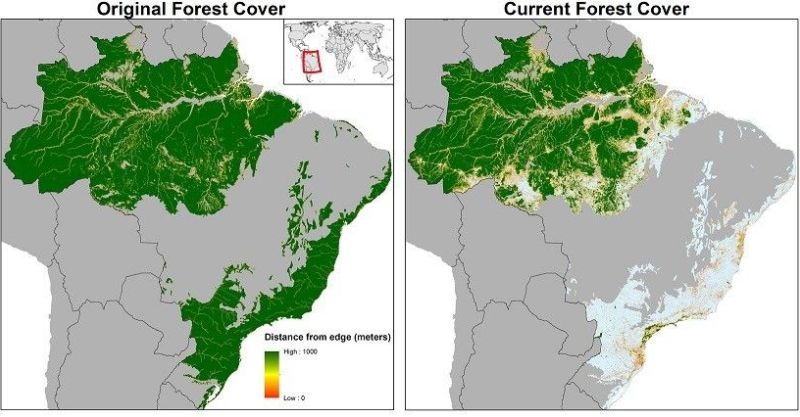File:Amazon deforestation timeline.jpg
Amazon_deforestation_timeline.jpg (800 × 417 pixels, file size: 64 KB, MIME type: image/jpeg)
Amazon Tipping Point
- Via Science Magazine / February 2018
By Thomas E. Lovejoy and Carlos Nobre
In the 1970s, Brazilian scientist Eneas Salati shattered the long held dogma that vegetation is simply the consequence of climate and has no influence on climate whatsoever. Using isotopic ratios of oxygen in rainwater samples collected from the Atlantic to the Peruvian border, he was able to demonstrate unequivocally that the Amazon generates approximately half of its own rainfall by recycling moisture 5 to 6 times as airmasses move from the Atlantic across the basin to the west.
From the start, the demonstration of the hydrological cycle of the Amazon raised the question of how much deforestation would be required to cause the cycle to degrade to the point of being unable to support rain forest ecosystems...
Where might the tipping point be for deforestation-generated degradation of the hydrological cycle? The very first model to examine this question showed that at about 40% deforestation, central, southern and eastern Amazonia would experience diminished rainfall and a lengthier dry season, predicting a shift to savanna vegetation to the east...
We believe that negative synergies between deforestation, climate change, and widespread use of fire indicate a tipping point for the Amazon system to flip to non-forest ecosystems in eastern, southern and central Amazonia at 20-25% deforestation.
The severity of the droughts of 2005, 2010 and 2015-16 could well represent the first flickers of this ecological tipping point.
We believe that the sensible course is not only to strictly curb further deforestation, but also to build back a margin of safety against the Amazon tipping point, by reducing the deforested area to less than 20%, for the commonsense reason that there is no point in discovering the precise tipping point by tipping it. At the 2015 Paris Conference of the Parties, Brazil committed to 12 million ha of reforestation by 2030. Much or most of this reforestation should be in southern and eastern Amazonia. The hydrological cycle of the Amazon is fundamental to human well-being in Brazil and adjacent South America.
○
File history
Click on a date/time to view the file as it appeared at that time.
| Date/Time | Thumbnail | Dimensions | User | Comment | |
|---|---|---|---|---|---|
| current | 21:11, 30 October 2018 |  | 800 × 417 (64 KB) | Siterunner (talk | contribs) |
You cannot overwrite this file.
File usage
The following 2 pages use this file:
